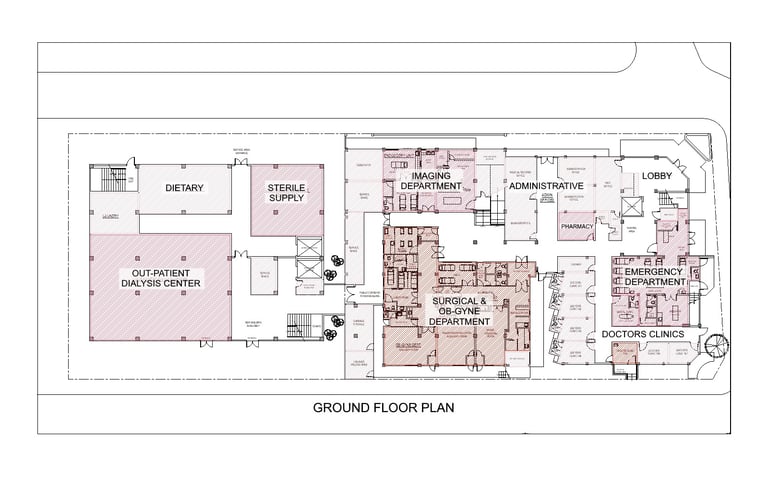Optimizing Healthcare Facility Design with Infection Control Zone Analysis
One of the considerations when designing healthcare spaces is infection control. This analysis identifies non-sterile, sub-sterile, and sterile zones in the plan, to help create a layout that minimizes the spread of infection.
SPACE
Rich Lasam
3/28/20253 min read


When healthcare facilities are being planned, the safety and health of the people in the space are one of the primary considerations of design. All end-users of the building—from the patients who need care, to visitors of the facility, and the doctors and staff who work there—need to be protected from potential ailments that can be acquired within the facility.
In terms of design, the layout of the building should reduce the chance of infection spread within the facility—to create such a layout, the process is known as Infection Control Zone Analysis. Even before COVID-19, Hospital Acquired Infections (HAIs) are an ongoing concern in medical premises. HAIs are cases in which patients and visitors get sick with another illness from visiting or staying in the healthcare facility.
Infection Control Zone Analysis is a design process that can be applied to both new projects and existing healthcare facilities. This zoning analysis is part of the Master Plan process and should be considered as another layer of design analysis that influences the overall master plan direction of the design of healthcare facilities.
The process identifies the spaces that should be areas of concern for the architect and the end-users in terms of preventing infection spread. This is done by dividing and identifying the spaces within the healthcare facility into three distinct contamination level zones: Non-Sterile, Sub-Sterile, and Sterile. As much as possible, departments and spaces with similar accepted levels of contamination should be grouped together.
For existing facilities, this zoning analysis can be utilized for assessment of the current conditions of the building, providing a visual guide for the stakeholders on the direction of the Master Plan. For new facilities, this helps ensure that contamination and infection points are kept to a minimum. In the post-pandemic age after COVID-19, controlling infection spread will be a paramount concern to ensure that the facility can operate even in the middle of a local epidemic or a future pandemic.


Non-Sterile Zone: This zone is for departments that have little to no sterility requirements. Generally, the most public areas of the healthcare facility.
Zone Color: Light Pink
Sample Spaces: Medical Arts Building, Clinics, Physical Therapy, etc.
Sub-Sterile Zone: This zone is for departments that need minimal sterility requirements. Minor surgical operations are conducted in the spaces, so a certain degree of localized infection control directives is required.
Zone Color: Pink
Sample Spaces: Ambulatory Surgery Center, Eye Clinic, Dialysis, etc.
Sterile Zone: This zone is for departments requiring stringent infection control and cleaning due to the nature of activities being conducted in them. These spaces should be located in private areas of the facility, away from general travel routes.
Zone Color: Red
Sample Spaces: Surgical Department, Intensive Care Units
Identification of infection points
The goal of the Infection Control Zoning Analysis is to show visually where there are potential infection points that need to be addressed. Departments with similar sterility requirements should be grouped together as much as possible, and travel pathways need to be studied and examined to reduce the chance of potential spread of diseases in the healthcare facility. Infection points are areas in the healthcare facility in which a change of sterility between departments occurs due to changes in the requirements of the space. Access points, entrances, and waiting areas, depending on the specifics of the healthcare facility, can also be identified as infection points.
Below is a sample application of the zoning colors on a floor plan. With these colors, you can see right away the areas that need to be sterile. Similar colors should be adjacent or grouped together as much as possible and look like this. In comparison, a dark-and-light speckled plan means the layout should go back to the drawing board.


Overall, this type of zone analysis is both useful for new projects and assessing existing ones. Aside from Infection Control, there are other zoning analyses that are done for healthcare facilities, such as a Fire Safety Assessment, Time Operations Zoning and the most common analysis, Site Utilization Analysis which I talked about before. What really sets healthcare facility design apart from other building types is the number of considerations you must remember during the design process, and I find the best way to be an architect in this specialty is to divide the problem into smaller components and work on each one by one, then combine it to a cohesive design.
